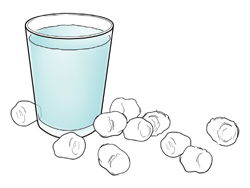The Wonders of Cotton
God created plants on Day Three of the Creation Week (Genesis 1:12–13) around 6,000 years ago, and He designed them with some amazing qualities that are very helpful to people. Cotton is one of those plants!
Cotton has been grown by humans on farms for thousands of years because of its value in making clothing and other items. This is historically documented.
Not long after the Flood, people as far afield as India, Egypt, and Mexico spun the fibers into necklaces and clothing. Megasthenes (ca. 350–290 BC), a Greek historian who lived around the time of Alexander the Great (356–323 BC), told a yarn about the “trees that grow wool” he’d witnessed in Southeast Asia. (Such stories caused some Europeans to imagine the plants had tiny sheep growing out of them.)1
You may have noticed that the tags on many items of clothing, including some that you wear, list cotton as part of the material. Cotton is used in clothing because it produces a strong fabric that is light and airy. You can observe this by squeezing a cotton ball. If you roll the cotton ball into a short strand and then try pulling it apart by the ends, it can be hard to break. Now soak your cotton strand in water, and try to pull it apart by the ends. Is it easier or harder to break? Cotton is very absorbent, which means that it can soak up and hold a lot of liquid.
A single 500-pound (227 kg) bale of cotton can be stretched to produce 215 pairs of jeans, 250 single bed sheets, 4,300 pairs of socks, 1,200 T-shirts, 2,100 pairs of shorts, or 680,000 cotton balls.
Cotton is not like leather or many other heavy types of clothing material. The loosely packed fibers in cotton make for a breathable, hypoallergenic fabric that doesn’t make you simmer in summer. But the same fabric, when layered, serves well in wintertime, as good as any blanket, because it is such a good heat preserver.2
Would you like to explore some of the qualities of cotton first-hand by performing a fun experiment?3 You will need an adult’s help.
See For Yourself . . .
Cotton feels fluffy because there’s a great deal of empty space in there. That’s one reason it’s so cool to wear. You probably never realized just how much empty space there is, but you’ll see a hint of that in this experiment. Note: Make sure you get your parents’ permission to plunder their cotton ball collection, and you should do this experiment on a water-resistant surface or outside.
What You’ll Need

A bag of large cotton balls
A small glass
Water
A towel to dry up any spills
(a cotton towel, of course)
What You’ll Do
- Fill your glass with water to about 1/4 inch (0.5 centimeter) from the top.
- Make your best guess of how many cotton balls you can fit into the glass before the water overflows. Write it down.
- Drop in a few cotton balls.
- Write down what happened.
- Now put in as many cotton balls as will fit. Gently press them down with your fingers, without spilling, if you need to make more room.
- Let the cotton balls dry, and you can reuse them. (They might be a bit deformed, but they’ll still work.)
Reflect
Were you surprised by how many cotton balls could fit in the glass?
How could this property of cotton be useful around the house or in other situations?
[Editor’s Note: Adapted from an article by John UpChurch, “Experiment: Cool Cotton,” Answers, October–December 2013.]
Footnotes
- John UpChurch, “Experiment: Cool Cotton,” Answers, October–December 2013, 37–38, https://answersingenesis.org/physics/experiment-cool-cotton/.
- Ibid.
- Ibid.
Recommended Resources
- © 2025 Answers in Genesis
- Privacy Policy
- Contact
- About

